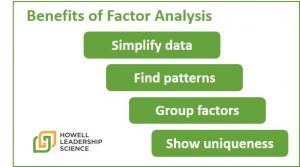Using factor analysis thinking to build a competency model

If you need to create clear and distinct thoughts, survey items or discussion points for a presentation or paper, you would benefit from understanding factor analysis thinking.
What is factor analysis thinking?
Factor analysis thinking leverages the concepts of a complicated statistical procedure and applies them to your every day work.
Factor analysis thinking is about simplicity, patterns, clarity and uniqueness of ideas and data.
Statistical explanation of factor analysis
In the article “Research Terminology: What is Factor Analysis?“, I introduced the statistical concept of a factor analysis and provided examples of how it is used in research.
In addition to the statistical use, the concepts of factor analysis can also be leveraged for practical, every day work.
Check out the earlier article for the technical definition of a factor analysis.
Practical definition of factor analysis
A practical definition of factor analysis is that it takes a big set of data and groups parts of the data together into smaller, related chunks. This makes the data more manageable and can help identify relationships in the data that were not obvious before.
The smaller, related chunks of data are called ‘factors’.
Benefits of factor analysis

My practical, non-jargony view of factor analysis is that it does four key things:
- Simplify data – it takes a big set of data and groups it into factors. The factors are easier to interpret than the full data set.
- Find patterns – it finds patterns in the data in order to do the factor grouping. The underlying pattern (sometimes called a latent or confounding variable) might only appear after the factor analysis finds the relationships.
- Group factors – the output of a factor analysis is the factors. These factors can become variables themselves and can also reveal data that does not fit with any of the other factors.
- Show uniqueness – strong factors include data that is related and does not include unrelated data. This creates a pure (at least relatively pure) construct that is different from the other factors.
Using factor analysis thinking at work
Personally, I have not run a statistical factor analysis since graduate school, but the concepts still helps me in my work.
I find myself using factor analysis thinking when I develop competency models, surveys, assessments or other models with many elements and a lot of data.
In this example, I’ll describe how factor analysis thinking can support the development of competency models.
What is a competency model?

Many companies develop a competency model to describe expected behaviors for employees. These competency models often look similar across most organizations and focus on leadership skills such as communication, leading in change, building relationships, being inclusive and strategic thinking.
The company uses these models to hire employees, evaluate them in performance reviews, identify high potentials, design leadership programs and 360 degree feedback assessments.
Since these competency models contribute to key talent management activities, it is important for them to be clear, concise and well-designed. Factor analysis thinking can help with that.
Apply factor analysis thinking to building a competency model

Step 1: Simplify data. A competency model has already taken a bigger set of data (all possible behaviors) and simplified it into a smaller set of information (the ones expected by employees at that company).
Step 2 and 3: Find patterns and group factors. Competency models generally group related items together. For example, one competency about communication might have three items involving being clear in communication, active listening and having good presentation skills. Those three behaviors are grouped into one competency. That competency of communication might be further grouped with other competencies into a section about Personal Effectiveness.
Step 4: Show uniqueness. Factor analysis thinking also helps ensure that the factors are unique and separate from each other. Many companies miss this critical step on competency models and also with surveys. The company has lots of good ideas, but tries to shove unrelated or loosely related concepts into one item or one competency.
When one item contains multiple ideas, it creates confusion about what is really important. A rater will struggle to evaluate someone on an item with multiple ideas, because the ideas might conflict. Uniqueness requires one key idea per item in order to ensure clarity.
Factor analysis thinking helps create a competency model that has clear competencies that are unique from each other and have distinct behaviors within them.
This clarity creates a competency model that employees understand. A clear and well-designed model should become accepted and foundational. It can use for performance feedback without getting off-base by debating the wording of the items.
When factor analysis thinking is missing
When the focus is not on distinct and unique factors, the competency model gets convoluted.

At one company, I saw this item for a competency labeled ‘Building Effective Relationships’:
“Proactively initiates connections with key stakeholders and team members; responds to unexpected problems by encouraging dialogue; avoids volatile reactions and criticisms.”
All of the ideas in that competency are good ones. But if you apply factor analysis thinking to this item, you can see the problems. That competency contains three separate ideas.
The first one involves relationship building. The second one deals more with problem solving, and the third one is about self-control and staying calm. If you had to rate someone on ‘Building Effective Relationships’, which of those three components would you focus on?
Additionally, this competency overlapped with another competency called ‘Building Alignment”. The competency did not strongly group the concepts within itself into one solid factor and it was not unique compared to another competency.
It failed the factor analysis thinking test.
How can factor analysis concepts help you do your work?
Consider the example above and situations in which you can apply factor analysis thinking. Maybe you are designing a competency model or a survey.
You could also use factor analysis thinking for grouping ideas together for a presentation or clustering descriptive words for a marketing campaign.
As you do your work, keep factor analysis thinking in mind. Simplify data, find patterns, group group factors and show uniqueness.



